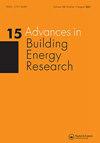The role of design parameters on the performance of diffuse ceiling ventilation systems – thermal comfort analyses for indoor environment
IF 2.5
Q2 CONSTRUCTION & BUILDING TECHNOLOGY
引用次数: 3
Abstract
ABSTRACT Thermal comfort conditions profoundly affect the occupants’ health and productivity. A diffuse ceiling ventilation system is an air distribution system in which the air is supplied to the occupied zone with relatively a low velocity through the perforated panels installed in the ceiling. The current study evaluated the impact of diffuse ceiling design parameters, i.e. diffuse panel configurations and heat load distributions, on the thermal comfort condition of the occupants. In this regard, the computational fluid dynamics technique was used to evaluate thermal comfort conditions in a waiting room, meeting room and office. The central and dispersal configuration of active diffuse panels was considered. The PMV-PPD model was applied to evaluate the overall occupants’ comfort, while the draft rate was considered to assess local thermal comfort. The model validation was performed by comparing the collected laboratory measurement data. Overall, the results indicated that the central active diffuse panel configuration had a better thermal comfort than the dispersed one. The evaluation of dispersed configuration in realist scenarios, including office and waiting room, had the highest dissatisfaction, with a PPD value of 9%. Local thermal comfort assessment revealed that dispersed configuration had the highest draft rate of 14% in the office.设计参数对天花板扩散通风系统性能的影响——室内环境的热舒适性分析
摘要热舒适条件对居住者的健康和生产力有着深远的影响。天花板扩散通风系统是一种空气分配系统,其中空气通过安装在天花板上的穿孔板以相对较低的速度供应到被占用的区域。目前的研究评估了漫射天花板设计参数(即漫射面板配置和热负荷分布)对居住者热舒适条件的影响。在这方面,计算流体动力学技术被用于评估候诊室、会议室和办公室的热舒适条件。考虑了有源扩散板的中心和扩散配置。PMV-PPD模型用于评估整体居住者的舒适度,而通风率用于评估局部热舒适度。通过比较收集的实验室测量数据进行模型验证。总体而言,结果表明,中央有源扩散板配置比分散型具有更好的热舒适性。在包括办公室和候诊室在内的现实场景中,对分散配置的评估不满意程度最高,PPD值为9%。局部热舒适性评估显示,分散式配置在办公室的通风率最高,为14%。
本文章由计算机程序翻译,如有差异,请以英文原文为准。
求助全文
约1分钟内获得全文
求助全文
来源期刊

Advances in Building Energy Research
CONSTRUCTION & BUILDING TECHNOLOGY-
CiteScore
4.80
自引率
5.00%
发文量
11
 求助内容:
求助内容: 应助结果提醒方式:
应助结果提醒方式:


